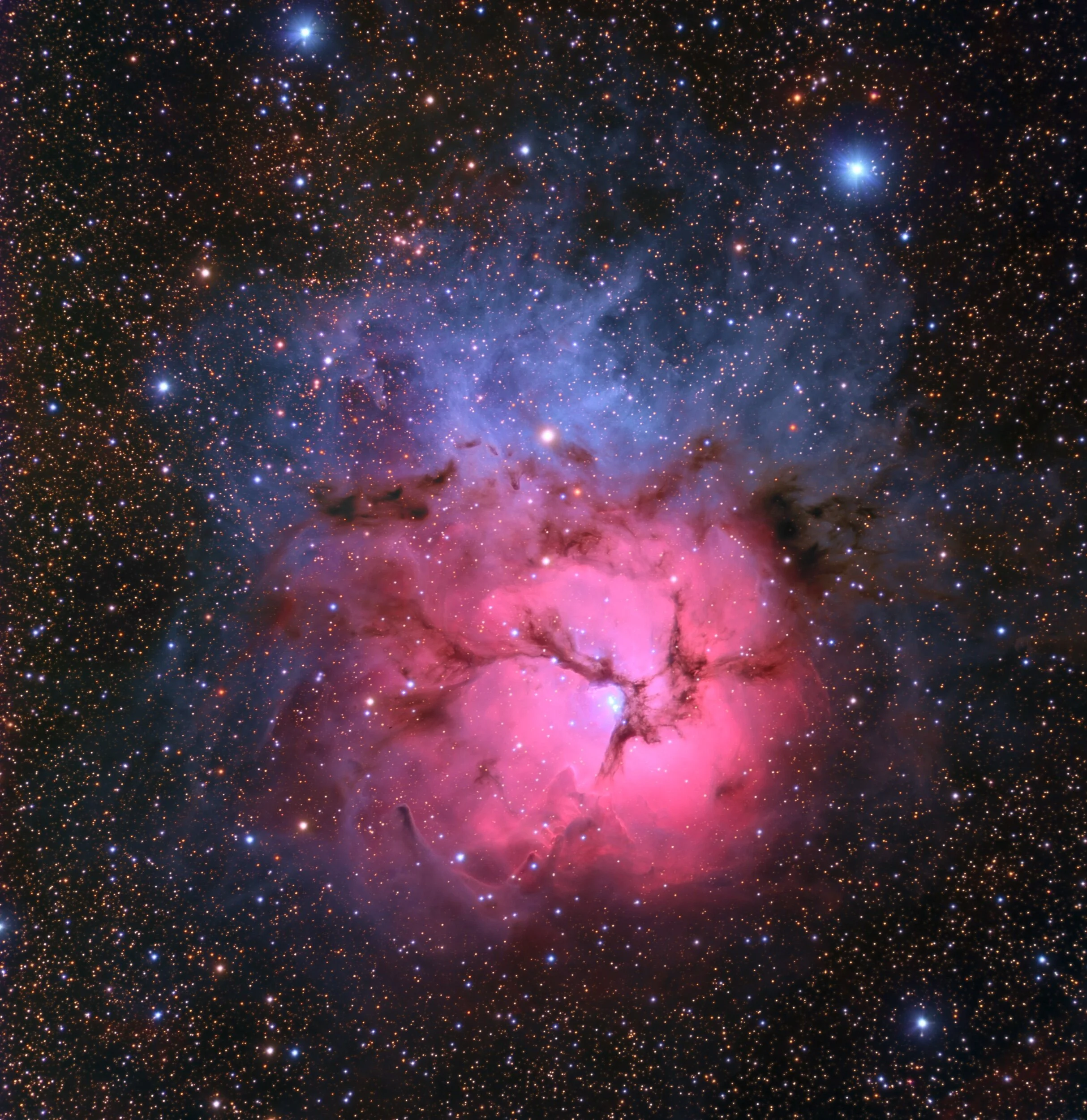
AAPOD2 Image Archives
The Trifid Nebula
Featured Astrophotographer on AAPOD2
The Trifid
Located approximately 5,000 light years away in the constellation Sagittarius, the Trifid Nebula (M20) is a rare combination of three distinct nebula types in one region: emission (red), reflection (blue), and dark (silhouetted against the background glow). The striking red glow comes from ionized hydrogen gas energized by ultraviolet radiation from young, massive stars, while the blue haze reflects starlight off interstellar dust.
The nebula's signature dark lanes appear to divide it into three lobes, giving it the name "Trifid." These dust structures are part of active star-forming regions where gravity and turbulence shape dense clouds. This natural color image beautifully captures the balance between structure and chaos in one of the galaxy’s most photogenic nurseries.
The Trifid Nebula in 81 Hours
The Trifid Nebula, also known as M20, is a rare combination of emission, reflection, and dark nebulae located in the constellation Sagittarius. This deep view reveals the intricate structure of the nebula, including the red glow of ionized hydrogen gas (Hα), the bluish reflection from nearby starlight, and the dense dust lanes that divide its bright core into three lobes. These dust lanes are responsible for the nebula’s common name, derived from the Latin word trifidus, meaning "divided into three lobes."
Captured with a total of 81 hours of exposure in Hα, RGB, and [OIII] filters, this image showcases both the rich star field of the Milky Way and the dynamic processes at play in this active star-forming region. Newborn stars within the nebula irradiate the surrounding gas and dust, triggering additional waves of star formation and sculpting the surrounding material into dramatic shapes.
The Lagoon and Trifid Nebula in Foraxx/HSO
This image captures the stunning beauty of the Lagoon Nebula (M8) and the Trifid Nebula (M20) in the narrowband color palette of Foraxx/HSO (Hydrogen-Alpha, Sulfur, and Oxygen). Situated in the constellation Sagittarius, these celestial wonders showcase their intricate structures and vivid colors in this composite view.
The Lagoon Nebula, resembling a celestial lagoon surrounded by dark lanes of interstellar dust, is a region of intense star formation. In contrast, the Trifid Nebula exhibits its distinctive three-lobed appearance, with blue reflection nebulae, dark lanes, and pink emission regions. The Foraxx/HSO color scheme emphasizes the unique emissions of hydrogen, sulfur, and oxygen, revealing the dynamic interplay of gas and dust within these nebulous regions. This image is not only a visual feast but also a scientific treasure trove, offering valuable insights into the birth and evolution of stars in our galaxy.
M20 - NGC 6514 - The Trifid Nebula
Image Description and Details :
This is my image of the wonderful and iconic Trifid Nebula. It is about 4100 ly away and is 42 ly across.My 0.54 degree x 0.54 degree field of view, beautifully accommodates it.Capture details:Dates; 2021-04-22 to 2021-05-18Lights: 24.5 hours integrationLum: 32 x 600 secsRed: 23 x 600 secsGreen: 22 x 600 secsBlue: 22 x 600 secsBias: 35Darks: 35Flats: 20 per colour channel per camera changeThere are some very bright foreground stars, which I decided not to reduce too much through Morphological Transformation, as compositionally I feel they add a lot to the image. My image scale and advantageous latitude, which means the object was at a good altitude throughout the imaging runs, plus generally decent seeing meant that good resolution of detail was possible. I was particularly pleased to resolve the stellar jet as imaged by the HST. This is a Herbog-Haro object numbered HH 399.
Copyright: Niall MacNeill
The Trifid Nebula in Sagittarius
The complex cloud displays an unusual combination of both red emission and blue reflection areas as well as numerous intricate dark patterns. The nebula is located 9000 light years away in the direction towards the galactic centre. The entire area is sprinkled with thousands of stars and fainter dusty and nebulous areas throughout. A separate prominent dark cloud appears dramatically silhouetted against the starry background to the right.A curious example of gas evaporation can bee seen near the core of the Trifid itself. Here a dense stalk, 8 light years from the centre, is emerging from the edge of the bubble surrounding the central cluster, and in the other direction a powerful stellar jet from a young star, HH 399 embedded in the gas, is shooting out in an upwards direction. The bright young stars in the central cluster emit strong radiation which eats away the surrounding gas and dust. The stalk only appears because a denser region lies at its very tip and protects a thin strip of the cloud from this interstellar erosion. The Hubble Space Telescope has imaged this fascinating area in high resolution: http://imgsrc.hubblesite.org/.../hs-2004-17-a-print.jpg. Throughout the nebula lies countless young T Tauri stars just having emerged from their birthplaces inside the gas and dust. These are typically rather faint and reddish, though they are more easily visible in this image of another stellar nursery near AntaresImage details: Date: May - September 2020Exposure: HaLRGB: 270:916:190:190:195 mins, total 29 hours 21 mins @ -25CTelescope: Homebuilt 12.5" f/4 Serrurier Truss NewtonianCamera: QSI 683wsg with Lodestar guiderFilters: Astrodon LRGB E-Series Gen 2 and 3nm H-AlphaTaken from my observatory in Auckland, New Zealand See Less
Copyright: Rolf Wahl Olsen






